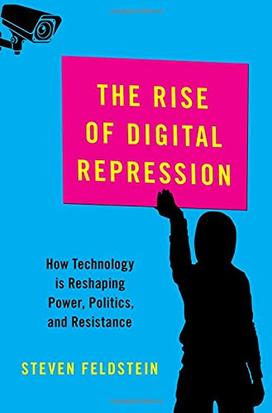Steven Feldstein ’00 Delves Into Digital Repression


Opening lines: In 2017, I began to think seriously about digital repression. I had just completed a three-year stint at the U.S. State Department overseeing democracy and human rights issues for Africa. After my departure, I suddenly had much more time to reflect on emergent trends and over-the-horizon issues. I began to hear about a new form of repression taking place in Xinjiang, China. Chinese authorities were systematically harnessing digital technology to persecute millions of citizens in ways I had never encountered before. I started digging into the matter further. What I uncovered was chilling.
Under the leadership of a regional party secretary named Chen Quanguo, who had gained a reputation in his prior post by pioneering brutal grid-policing tactics in Tibet, Chinese security forces had instituted a police state of Orwellian proportions. Authorities, I learned, were collecting mandatory DNA samples in order to build a genetic database for the region’s entire ethnic Uighur population. The police were monitoring all electronic communications: text messages, social media posts, phone calls, and visited websites. Checkpoints had been established at every border crossing to track who was coming and going in the province, and to record specific information, including SIM card numbers, license plate registrations, and passports. In public squares, ubiquitous cameras equipped with facial recognition capabilities and powered by advanced algorithms kept watch over Xinjiang’s towns and cities.
The developments in Xinjiang were shocking. They also raised a slew of questions. Did such digital monitoring represent the new face of repression? Were Chinese authorities exporting these technologies and tactics to other governments to enable them to persecute their citizens? How did Xinjiang’s surveillance and censorship repression strategy relate to other digital strategies such as Internet shutdowns or online disinformation campaigns against domestic opponents? I started to grasp that what was happening in Xinjiang fit a broader pattern of repression taking place around the world. China was not an exception but part of a larger trend, where autocrats increasingly turn to digital technology to augment and sharpen their programs of repression.
These insights became the rationale for the book—to investigate and make sense of a new model of repression that is profoundly shifting the coercion paradigm.
This book is first and foremost about how governments repress—how autocratically inclined leaders are deploying new digital methods to reinforce their power, shape political narratives, counter dissent, and push back against mass protests. My purpose is to contribute to the current understanding of the goals, motivations, uses, and drivers of digital repression strategies. I do not wish to leave the mistaken impression that technologically advanced tools have fully upended the balance between citizen and government. Rather, I believe that the political landscape is marked by an ongoing struggle between multiple sets of actors (including private companies), and that many factors contribute to determining whether protest movements or opposition challengers will gain power or whether repressive leaders will prevail. This aligns with Ronald Deibert and Rafal Rohozinski’s “access contested” construct for cyberspace, in which they describe an “increasing struggle for superiority and the competition for power, influence, and control.” While this book focuses on the digital repression side of the equation, there are many innovative tools, ideas, and strategies that civil society groups and opposition movements are successfully implementing to counter autocracies. The news is not completely gloomy even if it is frequently discouraging. I will discuss countervailing strategies in the final chapter of the book.
I chose to focus on state-led digital repression because it represents a swiftly evolving area that remains understudied. There is still a significant amount we do not understand about these trends. Quantitative data remains scarce, and rigorous case-study research is also limited. Yet significant developments are rapidly occurring, many of which bring major policy repercussions. Governments like China’s are deploying digital strategies that signify elemental shifts in how states wield power. Gaining a better understanding of the logic and trade-offs behind these tactics and methods is imperative. We should also recognize that governments are no longer on their heels when it comes to confronting civic movements online. They have adapted and are using new tools to strengthen their hold on power. Shedding light on the costs and benefits of these tools will provide an important contribution to our understanding of authoritarianism.
The broader political landscape in which digital repression is unfolding is worrisome. Democracies worldwide are undergoing a troubling period of retrenchment. There is a growing consensus that the world is experiencing a “third wave of autocratization.” For the first time in nearly 20 years, autocracies outstrip democracies: 92 countries or 54 percent of the world’s population currently live under authoritarian rule. Researchers from V-Dem estimate that 2.6 billion people, or 35 percent of the world’s population, are living through autocratization, a process inverse to democratization in which political rights and freedoms are increasingly limited. Such countries include liberal democracies like the United States, flawed democracies and hybrid regimes such as Brazil, India, and Turkey, and autocratic states like Thailand and Venezuela.5 In their book on political polarization, Thomas Carothers and Andrew O’Donohue describe how “new and old democracies alike are confronting a daunting array of internal and external challenges, from the crumbling of public support for long-established political parties and the swelling popularity of illiberal politicians to the growing assertiveness and influence of authoritarian powers and ideas across borders.”
As I was completing this book, the world was in the full grasp of the coronavirus pandemic. While it is too early to predict the long-term political effects of the virus, current indicators are troubling. Governments around the world have turned to digital tools to fight the virus’s spread. While many governments have legitimate reasons for deploying contact-tracing apps or using location-monitoring technology to track infections, there are increasing reports of privacy violations and human rights abuses. As states expand their use of digital tools, there has not been a concurrent dialogue to delimit protections, safeguards, and standards of use. Many states have categorically refused to set limits regarding how long they intend to use these tools or for what exact purpose. It is conceivable that for governments in places such as Russia, China, Thailand, or Turkey, heightened surveillance measures are here to stay.
Before I delve into the book’s key arguments, it is useful to describe how the digital ecosystem operates, as well as discuss why leaders choose to repress in the first place. The following two sections elaborate on these ideas.
Reviews: "Steve Feldstein delivers a book that will be viewed as indispensable to anyone concerned with the intersection of technology and the state, and particularly, the evolving impact on people's quest for freedom the world over. In original case studies, he details how the current rising tide of authoritarianism has been enabled by digital repression. This tide could recede; equally compelling are the strategies he outlines for democratic governments, for civil society activists, and for those in the private sector looking to stem the tide." — Sarah E. Mendelson, Distinguished Service Professor of Public Policy, Carnegie Mellon University, Former U.S. Ambassador to the UN's Economic and Social Council











No responses yet